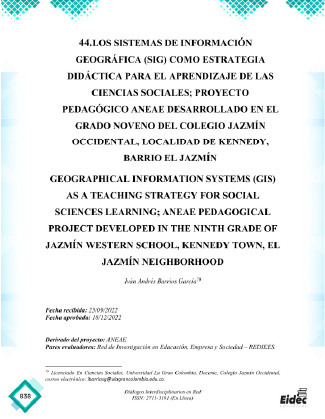XLIV. INFORMATION SYSTEMS GEOGRAPHY (GIS) AS A STRATEGY DIDACTICS FOR THE LEARNING OF THE SOCIAL SCIENCES; PROJECT ANEAE TEACHING DEVELOPED IN THE NINTH GRADE OF JAZMÍN SCHOOL WESTERN, KENNEDY LOCATION, THE JASMINE NEIGHBORHOOD
##plugins.themes.bootstrap3.article.main##
Abstract
GIS are data analysis tools that are developed to plan,
describe and identify spatial phenomena from cartographies. The making of maps
in the school environment, it is seen as a tracing activity that in the case of the diagnosis that
presents this project, resulted in scant analysis of students from
of your reading. GIS, in terms of cartography construction, requires various stages
that allow those who participate in the cartographic construction to soak up the reality
of the space where the mapping is generated; elaboration of surveys, observation of the
territories to be mapped and aerial photography are just some of the instruments that interact
with the people who generate the cartography. In this sense, the objective of the article is
present the development of the project implemented with the ninth grade of the Jazmín school,
where the purpose is to demonstrate the importance of GIS in the teaching of Sciences
social issues, their themes and skills in perspective of the specialization of phenomena
social. The methodology on which said project was based starts from a mixed perspective in
in terms of conclusions and in terms of the instruments for the elaboration of the maps.
Likewise, in this pedagogical exercise, significant learning is demonstrated from
of the use of this tool, resulting in not only better skills in the area
but also evolving in other transversal projects.
Download Statistics
##plugins.themes.bootstrap3.article.details##
Geographic Information Systems, Science Education Social, Didactics of Geography, Collaborative learning, Spatial analysis.
la educación. Universidad de la Rioja. España.
Hobsbawm, E., (1991). Naciones y nacionalismo desde 1780. Barcelona: Grijalbo.
Instituto Nacional de Estadística y Cartografía (2014). Cartilla lúdica: Sistemas de
Información Geográfica. México.
Korte, G., (2001). The GIS Book. (5th Ed. Rev.). Autodesk Press
Ministerio de Educación Nacional, (1994). Decreto 1860 de 1994. Bogotá, Colombia.
Ministerio de Educación Nacional, (2006). Estándares y lineamientos curriculares para
Ciencias Sociales. República de Colombia.
Montes, C., (2008). Los Sistemas de Información Geográfica como medio didáctico en la
enseñanza de la Geografía. Universidad de Antioquia. Medellín: Colombia.
Nieto, G., (2016). Análisis de la práctica educativa con SIG en la enseñanza de la Geografía
de la educación secundaria: un estudio de caso en Baden Württemberg, Alemania.
Universitat de Barcelona: España.
Parellada, C. A. (2017). Los mapas históricos como instrumentos para la enseñanza
de la historia. Tempo e Argumento, Florianópolis, 9 (21), 312-337.
Pulgarin, M., (2002). Enseñanza de las Ciencias Sociales integradas desde el estudio del
espacio geográfico. Medellín, Colombia.
Ramírez, M., & Téllez, J., (2006). La educación primaria y secundaria en Colombia en el
siglo XX. Banco de la República de Colombia.
Rojas, M. (2020). Los Sistemas de Información Geográfica como recurso pedagógico para
el proceso de enseñanza-aprendizaje de las Ciencias Sociales en la Universidad La
Gran Colombia.
Sampieri, R., (2008). Metodología de la investigación: sexta edición. Mc Graw Hill
Education. México D.F. Siso, G. (2010). ¿Qué es la geografía? Terra, 26 (39). Pp. 147-182.





